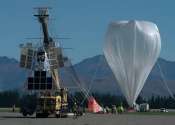Not in the path of totality? You can still watch Monday's total solar eclipse online
If you're nowhere near the path of totality or if clouds spoil your view, you can still catch the total solar eclipse online.

If you're nowhere near the path of totality or if clouds spoil your view, you can still catch the total solar eclipse online.
Space Exploration
Apr 2, 2024
0
36

NASA's Wallops Flight Facility supported the successful launch of a Rocket Lab Electron rocket at 3:25 a.m. EDT, Thursday, March 21, from Virginia's Mid-Atlantic Regional Spaceport on Wallops Island, Virginia.
Space Exploration
Mar 25, 2024
0
12

April's total solar eclipse promises to be a scientific bonanza, thanks to new spacecraft and telescopes—and cosmic chance.
Planetary Sciences
Mar 22, 2024
0
21

An astronomical telescope designed to complement the aging Hubble Space Telescope lifted off from New Zealand's south island on April 16 2023. But as a sphere the size of a football stadium rose silently and slowly over the ...
Astronomy
Mar 21, 2024
0
7

One of the many effects of global warming is sea-level rise due to the melting and retreat of the Earth's ice sheets and glaciers. As the sea level rises, large areas of densely populated coastal land could ultimately become ...
Earth Sciences
Jan 30, 2024
2
95

A pancake stack of radioactivity-sensitive films carried through the sky by a balloon was able to take the world's most accurate picture of a neutron star's gamma ray beam. To achieve this, Kobe University researchers combined ...
Astronomy
Dec 21, 2023
0
66

On a vast ice sheet in Antarctica, scientists and engineers are preparing a NASA experiment called GUSTO to explore the universe on a balloon. GUSTO will launch from the Ross Ice Shelf, near the U.S. National Science Foundation's ...
Astronomy
Dec 19, 2023
0
13

While the impacts of climate change vary across the globe, most scientists agree that, overall, a warming environment is increasing both the frequency and intensity of severe weather events such as tornados and intense thunderstorms.
Earth Sciences
Nov 30, 2023
0
910

An international team of astrophysicists, aerospace engineers and balloonists has found that data recovery capsules are a viable means of ensuring data integrity in the event of loss of flight capabilities or communications ...

The EU is seeking to limit growing threats from blazes through the use of satellites, artificial intelligence and unmanned aerial vehicles.
Environment
Aug 29, 2023
0
1
A balloon is an inflatable flexible bag filled with a gas, such as helium, hydrogen, nitrous oxide, oxygen, or air. Modern balloons can be made from materials such as rubber, latex, polychloroprene, or a nylon fabric, while some early balloons were made of dried animal bladders, such as the pig bladder. Some balloons are used for decorative purposes, while others are used for practical purposes such as meteorology, medical treatment, military defense, or transportation. A balloon's properties, including its low density and low cost, have led to a wide range of applications. The inventor of the rubber balloon, (the most common balloon) was Michael Faraday in 1824, via experiments with various gases.
This text uses material from Wikipedia, licensed under CC BY-SA